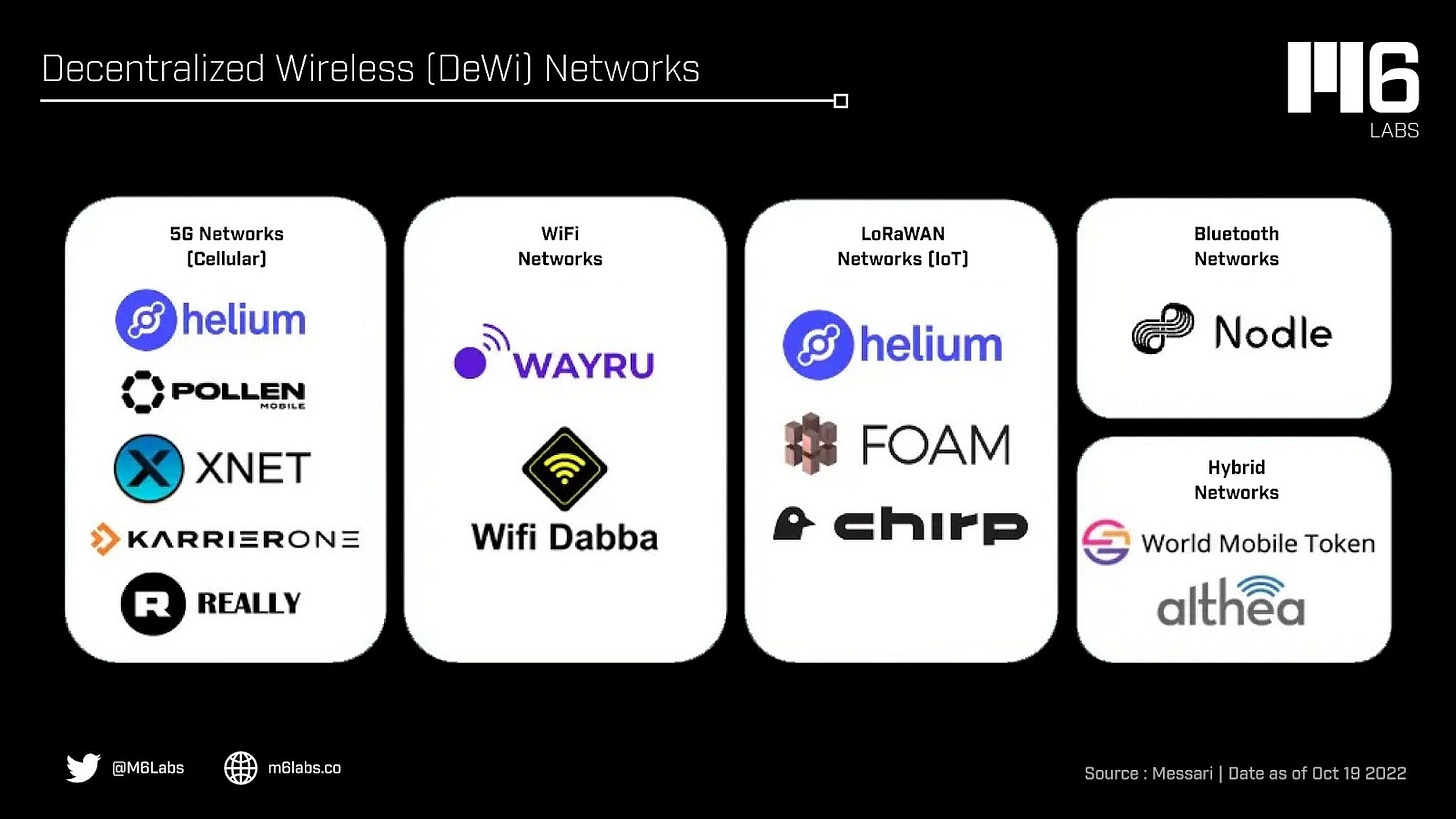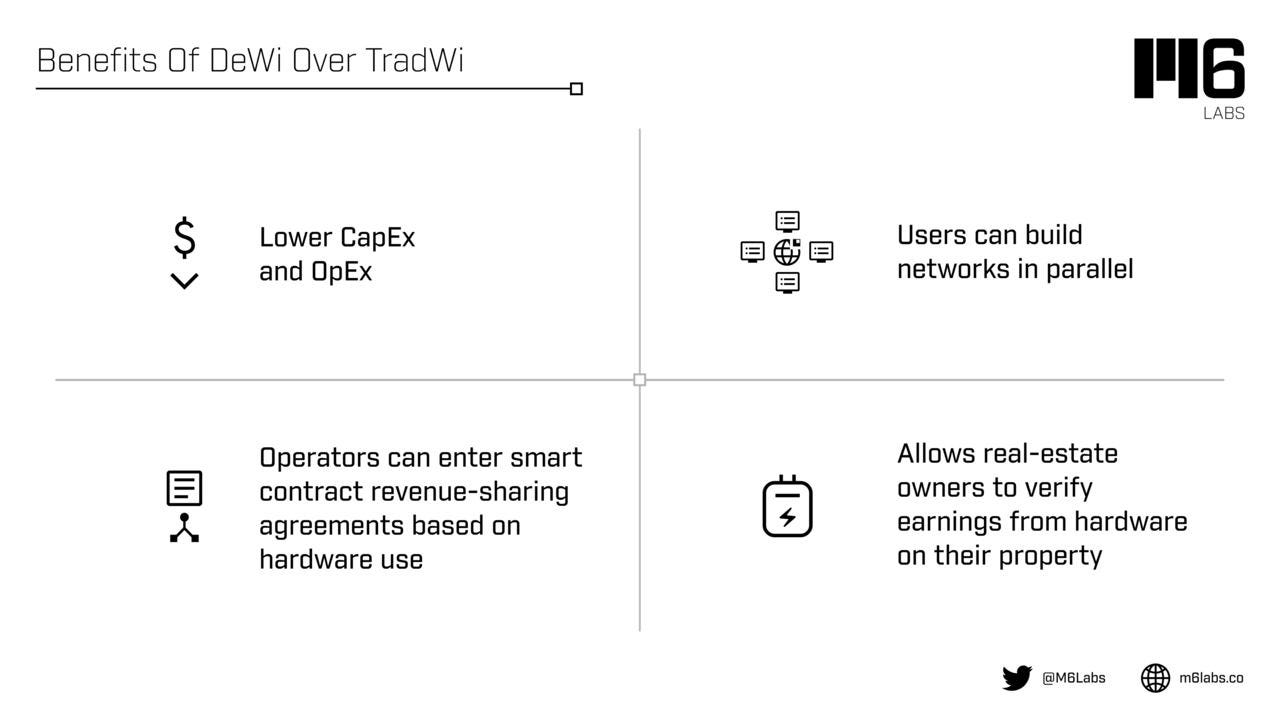Decentralized Wireless (DeWi) Introduction
Wireless networks are the gateway to the internet but aren’t transparent, which can soon change. DeWi aims to revolutionize how communication networks are built, operated, and owned.
Wireless networks are the gateway to the internet but aren’t transparent, which can soon change. Telecommunication services have controlled the communications stack for decades. With the internet transforming, hosting 4K videos and millions of IoT sensors, some question whether the telecommunications industry can serve the next generation of internet users.
Traditional wireless networks are restricted by bandwidth, congestion, service lags, and outages. Customers must deal with these issues in addition to determining the appropriate coverage, which is often complicated and costly. Many people do not have Internet access at all. A Cornell study found "low-income areas receive nearly 15% less network coverage than their affluent counterparts," resulting in a mobile divide. Because many people in low-income communities access the internet primarily through their cell phones, adequate coverage is critical. That's where the Decentralized Wireless (DeWi) narrative emerges.
Before we get started... Want early access to our research threads? Sign up to our Substack to receive daily coverage on everything you need to know about going on in the crypto directly in your inbox:
Done? Now let's dive in!
Decentralized Wireless (DeWi) aims to revolutionize how communication networks are built, operated, and owned by encouraging operators to deploy and maintain telecom hardware in exchange for token rewards.
Thanks to mobile phones, 66% of the world uses the internet, up from 7% in 2000. The amount of data created will only increase as internet connectivity, and access expand globally. The rise of new technologies, such as autonomous vehicles, the Internet of Things, smart cities, and virtual reality environments, has increased global demand for higher bandwidth and lower latency networks. Traditional wireless (TradWi) network operators cannot meet this increased demand.
Before we get into DeWi, we should discuss the traditional communication infrastructure. It's worth noting that telecom companies typically deploy new wireless networks every ten years. This procedure entails the following:
Taking on tens of billions of dollars in debt to fund capital expenditures and operating expenses,
Purchasing government spectrum licenses,
Using third-party manufacturers to create proprietary hardware,
Identifying property owners who are willing to host towers and radios,
Mobilizing thousands of field technicians to install and maintain complex equipment.
The top-down network-building model used by telecommunications companies is unsuitable for next-generation wireless networks. New network technologies, such as 5G, require significantly more radios and antennas, which telecom companies cannot afford. The telco model has historically prioritized coverage in densely populated areas, leaving many less populated and rural areas without adequate coverage.
There have been several exciting changes in telecommunications services over the years. Three significant shifts have positioned DeWi adoption to occur now: the mainstreaming of eSIMs, the opening of wireless spectrums, and the advancement of blockchain technology and wireless hardware.
Apple released the iPhone 14 last month with one significant difference: there is no longer a physical SIM card slot. The most recent iPhone supports a digital alternative known as an eSIM, which users can activate by scanning a QR code. This is an essential advancement for DeWi cellular networks because it reduces carrier switching costs to near-zero levels. Because the iPhone 14 has six eSIM slots, users can install a DeWi eSIM alongside their existing traditional carrier's eSIM and use both cellular networks.
The Helium Network, a new decentralized network, is working to address these systemic, costly, and inequitable issues by introducing coverage operated by a cluster of nodes, each emitting radio frequency from their location. Hundreds of thousands of people can easily earn rewards, gain more reliable coverage, and contribute to developing a robust network by allowing anyone with a Hotspot to participate.
While Helium provides an entirely novel way to build a network and has opened up the space just as the open source movement did for the internet, it is unlikely to be a one-size-fits-all technology.
Telecommunications companies are designed to cater entirely to consumers, increasing speeds and coverage, but their contracts are overly restrictive and untrustworthy. Telcos do not provide enough cost or coverage flexibility for enterprises using IoT devices and cannot offer the low-power, high-range that IoT is moving toward.
How Is All Of This Ties Together
The Helium Network runs on a proprietary algorithm called Proof of Coverage, verifying that Hotspots are located where they claim. Proof of Coverage consistently confirms that a Hotspot emits wireless network coverage from a specific location. It uses radio frequency (RF) technology to generate confirmations that aid in the operation of the network. According to the company, proof of coverage is based on three key characteristics: RF distance, RF strength, and RF speed. They use the PoC Challenge algorithm, which checks in on Hotspots to ensure they broadcast coverage from where they claim to be.
The "challenge" consists of the Hotspot that issues the challenge, the Hotspot that receives the challenge, and a nearby "witness" who reports the challenge's existence to the network. The Challenger Hotspot begins by generating a public/private key pair for the challenge. The SHA256 algorithm is then submitted to the blockchain as a Proof of Challenge request along with the public/private keys. If the request is valid, the blockchain will accept it and create a new block with the challenger's identity and a public key hash. Hotspots issue challenge proofs every 360 blocks and receive $HNT, Helium's token, in exchange. The data from a Hotspot is stored in the Helium blockchain once it has been checked and verified.
The company behind Helium, Nova Labs, has announced its intention to transform Helium into a decentralized platform on which any type of telecom network can be placed. This strategic shift transformed Helium into a network of networks. The process that allowed the LoRaWAN (Long Range Wide Area Network) to scale quickly can be replicated on various other network types, such as 5G, WiFi, VPN, and CDN.
Following the success of Helium's LoRaWAN network, Helium inspired many projects to launch new DeWi networks based on Helium's model. There are over 14 DeWi networks, including cellular, WiFi, LoRaWAN, Bluetooth, and hybrid networks:
5G Networks (Cellular): The Helium 5G and Pollen Mobile networks, which use the recently deregulated CBRS spectrum, are two prominent players in this category. The cellular market opportunity is the largest compared to other network market sizes.
WiFi Networks: DeWi WiFi networks aim to create a globally shared WiFi network that anyone can connect to for free. WayRu and WiFi Dabba are two early-stage projects in this space.
LoRaWANs (Internet of Things): LoRaWAN is a low-power, long-range wireless communication protocol. It is ideal for sending small data packets, such as sensor data, over long distances, making it the preferred network for IoT devices. This category also includes Helium and Foam.
Bluetooth Low Energy Networks: Bluetooth Low Energy networks are ideal for low-power and short-range applications. Nodle is a Bluetooth mesh network that connects IoT devices to the internet using smartphones and Bluetooth Low Energy routers.
Hybrid Networks: Decentralized internet connections are executed by hybrid networks combining various wireless technologies into a single solution. Althea and World Mobile Token are two such examples.
Here we can see an example of several DeWi Networks that you can explore as they build their products.
HNT: The Helium Network’s token
At the time of writing, HNT is currently trading at $6.64, with a market cap of $1.5B and a circulating supply of 100 million HNT.
The percentage of HNT distributed as rewards is determined by whether the node is a Challenger, Challenge, or Witness, as well as the type of work performed (verification, data transfer, issuing new blocks to the network). In addition, mining HNT is done using radio technology, as opposed to traditional mining, which uses energy-intensive GPUs.
DeWi networks, on the other hand, employ a novel token distribution mechanism that rewards participants for performing verifiable work in the real world. This incentive system is in charge of the economic flywheel that allows a network to be bootstrapped without the assistance of a centralized entity.
A protocol can motivate participants to bootstrap the supply side of a network until its coverage is extensive enough for end-user use. This enables protocols to gain the initial momentum required for adoption and competition with centralized telecommunication services. Operators receive ownership in the upside of the network in exchange for building out the supply side of it, which motivates them to see it succeed.
What are the benefits of DeWi over TradWi networks?
The most significant advantage DeWi has over TradWi’s network deployment is the lower CapEx and OpEx. Building networks the traditional way requires a centralized entity spending tens of billions of dollars on spectrum licenses, proprietary hardware with vendor lock-in, leasing land for deployments, paying thousands of field technicians to install and maintain equipment, and maintaining a massive back-end infrastructure for planning, onboarding, billing, and customer support.
Operators can use DeWi to enter automated revenue-sharing agreements based on the revenue generated by each hardware device. In TradWi deployments, operators must pay a fixed cost to landlords. Not only is the DeWi revenue-sharing model more efficient, but it allows real-estate owners to verify the earnings of the hardware on their properties and, thus, their revenue cut.
Next-generation wireless networks need an alternative deployment model to the traditional one. Historically, macro cell radios installed on large towers or masts provided cellular network coverage over a wide geographic area. The issue with macro cells is that they offer a low-frequency range, and 5G networks, unlike older-generation cellular networks, require higher-frequency bands for increased bandwidth. DeWi provides a more cost-effective solution for deploying 5G networks. Rather than replacing TradWi, DeWi can complement it. DeWi enables users worldwide to build networks in parallel, which is significantly faster than the centralized method. Participants who are knowledgeable about their jurisdiction can concentrate on deploying infrastructure that meets the needs of their local market. With TradWi's macro coverage and DeWi's small cell coverage, 5G may become more accessible worldwide.
The Future of Network and final thoughts
Decentralized Networks are the future of telecommunication services. Nova Labs is well-positioned to expand and strengthen its coverage. The DeWi sector is still in its infancy, but its potential to transform the telecom industry is undeniable. The rapidly growing number of protocols vying for a piece of the DeWi cellular market demonstrates significant opportunity.
Subscribe to receive our daily brief, extended weekly newsletter, and in-house research content!
Please Share, Leave Feedback, and Follow Us on Twitter, Telegram, and LinkedIn to stay connected with us.






